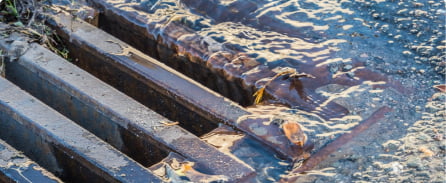Stormwater Infrastructure Construction
Whether your stormwater system has suffered a major failure, is outdated and no longer functioning as designed, or has lacked a preventative stormwater maintenance program for years and is no longer compliant with municipal regulations, it is likely in need of a retrofit or significant rehabilitation.
Stormwater infrastructure construction requires technical expertise and experience to ensure the end result is a properly functioning stormwater system that manages water quality and quantity. These large projects often entail engineering surveys, engineering design or redesign, geotechnical engineering, sediment assessments, permitting, regulatory compliance and communication, water quality monitoring and management as well as the actual construction or reconstruction of stormwater assets.
AQUALIS specializes in innovative retrofit and rehabilitation solutions for stormwater infrastructure to be functional for property owners.

Each asset in a stormwater system has a function. The most common include:
- Pretreatment
- Treatment
- Conveyance
- Infiltration
Rehabilitation of an already existing site is required when a constructed system fails. Rehabilitations are extensive reconstruction jobs that include removing the failing system and implementing a successful replacement. Because ground disturbance is essential to rehabilitation, these jobs often require engineering and construction plans, specialized equipment and authorized permits.
A stormwater system is a combination of multiple assets called Best Management Practices (BMPs) or Stormwater Control Measures (SCMs). These assets work cohesively to reduce volume of stormwater runoff, increase filtration and improve ground water recharge.
Pretreatment
BMPs created for the pretreatment of stormwater are installed to prevent the systems from being overloaded. They collect trash and act as an initial barrier for sediment. Having pretreatment assets prolong the life of your stormwater system and act as a first layer of defense. They can also function as a diversion for stormwater, slowing down the runoff so that downstream, it doesn’t overwhelm additional assets. Pretreatment devices cannot be installed independently and must always be used in combination with other assets.
- Screens
- Filter strips
Treatment
BMPs for treatment of stormwater filter and often store stormwater before returning it to the environment. Filtration through root systems, grasses and vegetation improve stormwater quality as excess pollutants like nitrogen are removed. Storage of the excess runoff also mitigates flooding. These BMPs will often be engineered with underdrains that carry filtered stormwater to surface waters or sewer systems.
Conveyance
BMPs built for conveyance prevent erosion and provide water quality treatment while diverting it to another location. They mitigate flooding and erosion by slowing the flow of stormwater and collecting debris and trash. Created for storm surges to divert stormwater from impervious surfaces. Often engineered to mimic natural practices with rip rap, native soils and vegetation.
- Step pool
- Stream channel
Infiltration
Stormwater infiltration is the process of stormwater permeating the subsurface soil. These BMPs are not engineered with underdrains and are expected to recharge ground water. They decrease peak flow rates and volume of runoff while reducing pollutants that flow further downstream. The vegetation inside these BMPs maintain natural site hydrology and create habitats for native species.
- Infiltration basins
- Infiltration trenches
- Bioretention areas
- Permeable pavements


